Inquiry-Based Learning Module: Zara's Business Strategy Analysis
VerifiedAdded on 2024/01/17
|11
|2361
|432
Report
AI Summary
This report provides an in-depth analysis of Zara's business strategy through the lens of inquiry-based learning. It begins by introducing the impact of the pandemic on the retail industry and Zara's response, followed by a background on Zara's success, sustainable and fast fashion concepts, and the impact of Covid-19. The analysis includes primary research gathered from Zara consumers, a SWOT analysis identifying Zara's strengths, weaknesses, opportunities, and threats, and an application of Porter's Five Forces to assess the competitive landscape. Key strengths include Zara's successful brand, vertical integration, and rapid design and distribution capabilities, while weaknesses include concerns about sustainability and limited marketing efforts. Opportunities lie in leveraging artificial intelligence and expanding online presence, while threats include intense competition and evolving trade policies. The report concludes with recommendations for Zara to enhance its marketing strategy through influencer marketing and address weaknesses to maintain its competitive edge in the fast-fashion industry.
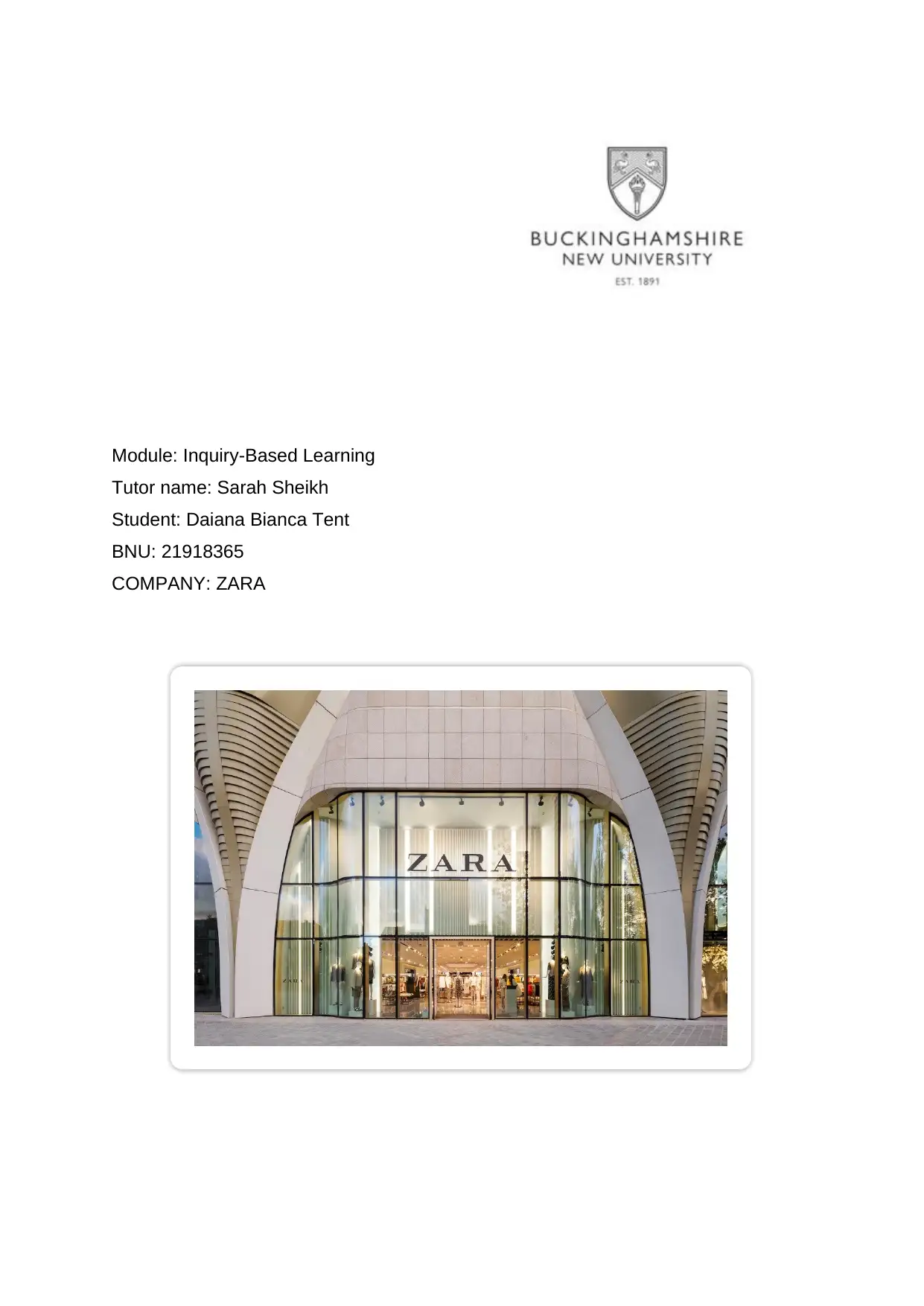
Module: Inquiry-Based Learning
Tutor name: Sarah Sheikh
Student: Daiana Bianca Tent
BNU: 21918365
COMPANY: ZARA
Tutor name: Sarah Sheikh
Student: Daiana Bianca Tent
BNU: 21918365
COMPANY: ZARA
Paraphrase This Document
Need a fresh take? Get an instant paraphrase of this document with our AI Paraphraser
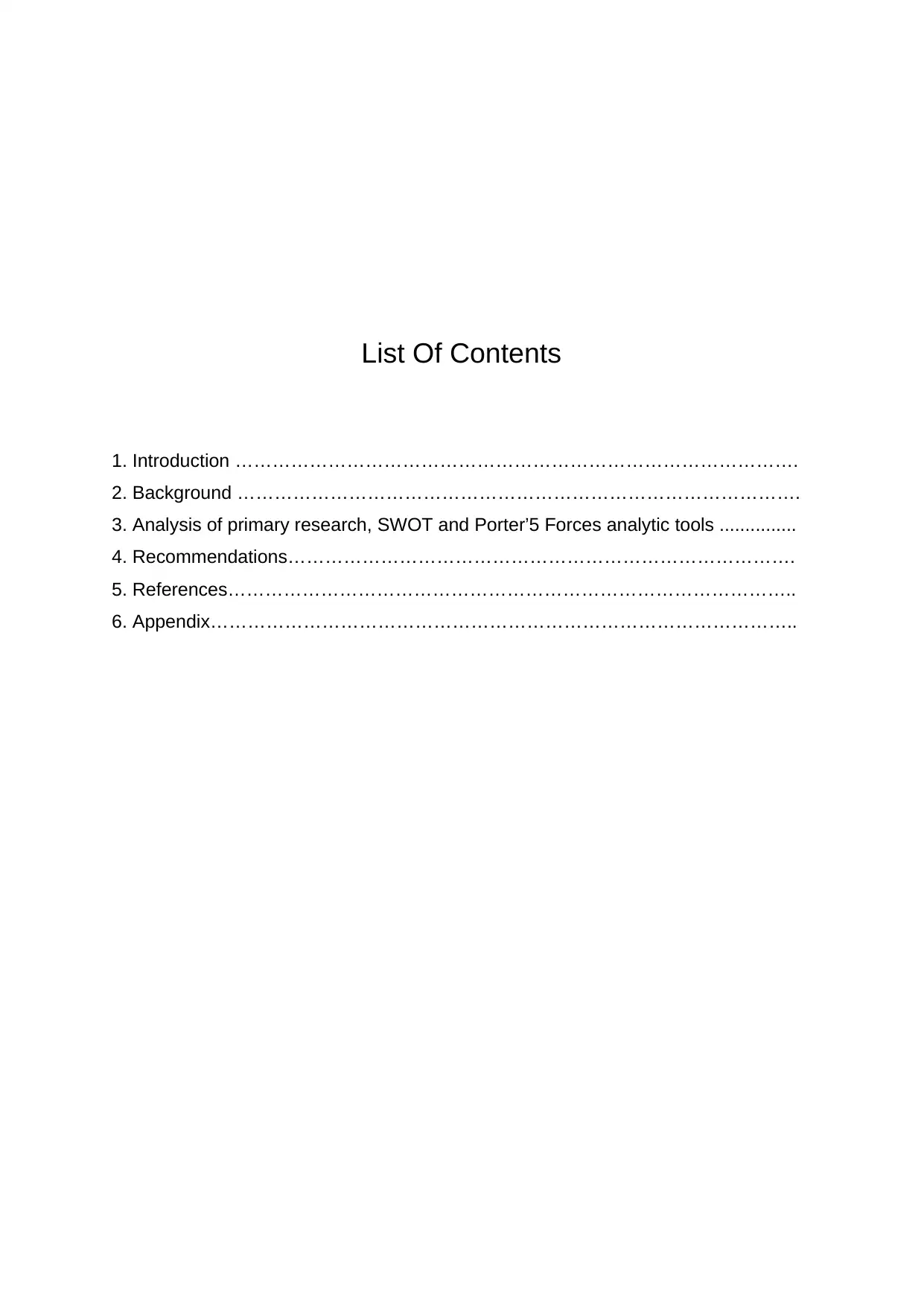
List Of Contents
1. Introduction ……………………………………………………………………………….
2. Background ……………………………………………………………………………….
3. Analysis of primary research, SWOT and Porter’5 Forces analytic tools ...............
4. Recommendations……………………………………………………………………….
5. References………………………………………………………………………………..
6. Appendix…………………………………………………………………………………..
1. Introduction ……………………………………………………………………………….
2. Background ……………………………………………………………………………….
3. Analysis of primary research, SWOT and Porter’5 Forces analytic tools ...............
4. Recommendations……………………………………………………………………….
5. References………………………………………………………………………………..
6. Appendix…………………………………………………………………………………..
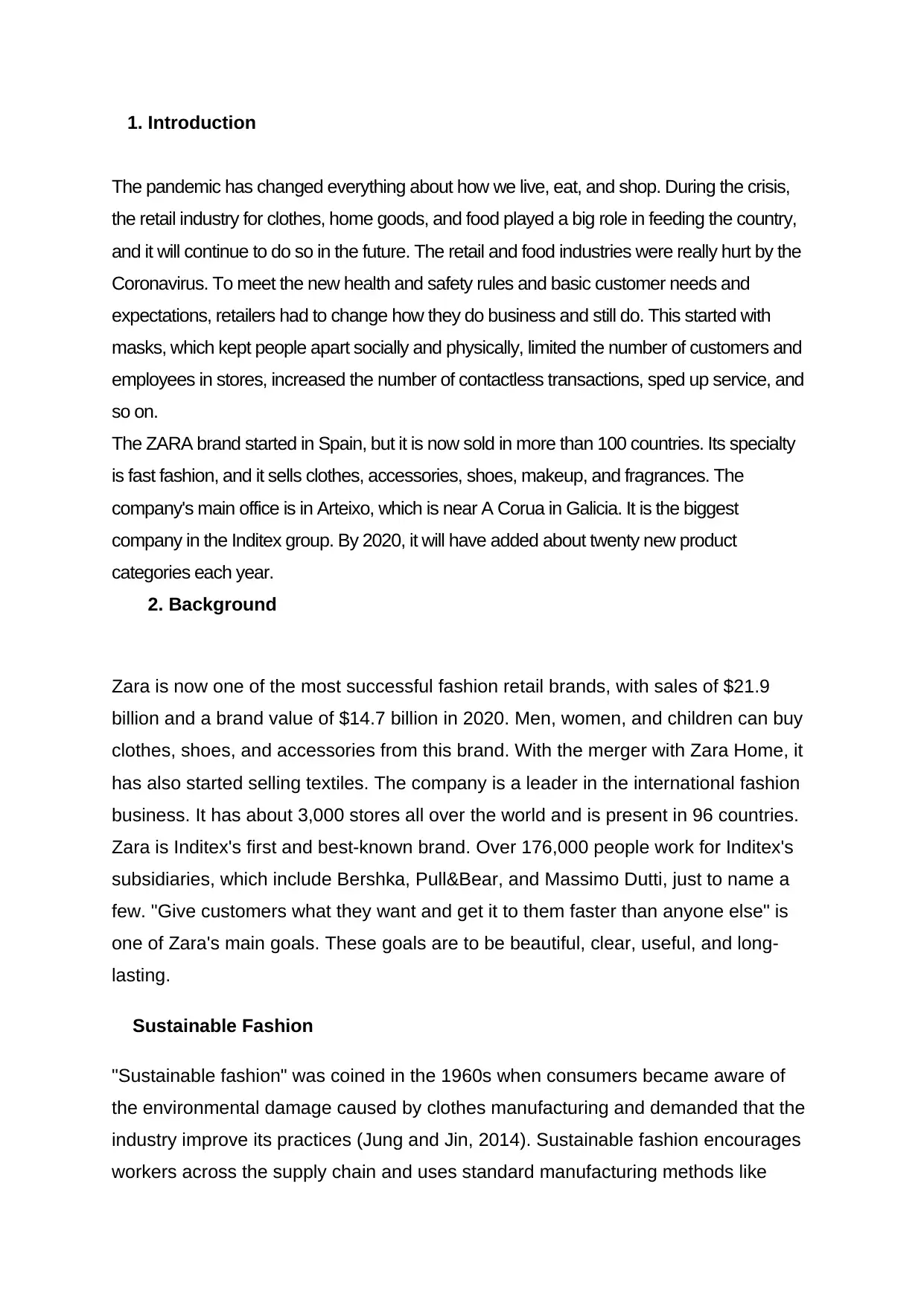
1. Introduction
The pandemic has changed everything about how we live, eat, and shop. During the crisis,
the retail industry for clothes, home goods, and food played a big role in feeding the country,
and it will continue to do so in the future. The retail and food industries were really hurt by the
Coronavirus. To meet the new health and safety rules and basic customer needs and
expectations, retailers had to change how they do business and still do. This started with
masks, which kept people apart socially and physically, limited the number of customers and
employees in stores, increased the number of contactless transactions, sped up service, and
so on.
The ZARA brand started in Spain, but it is now sold in more than 100 countries. Its specialty
is fast fashion, and it sells clothes, accessories, shoes, makeup, and fragrances. The
company's main office is in Arteixo, which is near A Corua in Galicia. It is the biggest
company in the Inditex group. By 2020, it will have added about twenty new product
categories each year.
2. Background
Zara is now one of the most successful fashion retail brands, with sales of $21.9
billion and a brand value of $14.7 billion in 2020. Men, women, and children can buy
clothes, shoes, and accessories from this brand. With the merger with Zara Home, it
has also started selling textiles. The company is a leader in the international fashion
business. It has about 3,000 stores all over the world and is present in 96 countries.
Zara is Inditex's first and best-known brand. Over 176,000 people work for Inditex's
subsidiaries, which include Bershka, Pull&Bear, and Massimo Dutti, just to name a
few. "Give customers what they want and get it to them faster than anyone else" is
one of Zara's main goals. These goals are to be beautiful, clear, useful, and long-
lasting.
Sustainable Fashion
"Sustainable fashion" was coined in the 1960s when consumers became aware of
the environmental damage caused by clothes manufacturing and demanded that the
industry improve its practices (Jung and Jin, 2014). Sustainable fashion encourages
workers across the supply chain and uses standard manufacturing methods like
The pandemic has changed everything about how we live, eat, and shop. During the crisis,
the retail industry for clothes, home goods, and food played a big role in feeding the country,
and it will continue to do so in the future. The retail and food industries were really hurt by the
Coronavirus. To meet the new health and safety rules and basic customer needs and
expectations, retailers had to change how they do business and still do. This started with
masks, which kept people apart socially and physically, limited the number of customers and
employees in stores, increased the number of contactless transactions, sped up service, and
so on.
The ZARA brand started in Spain, but it is now sold in more than 100 countries. Its specialty
is fast fashion, and it sells clothes, accessories, shoes, makeup, and fragrances. The
company's main office is in Arteixo, which is near A Corua in Galicia. It is the biggest
company in the Inditex group. By 2020, it will have added about twenty new product
categories each year.
2. Background
Zara is now one of the most successful fashion retail brands, with sales of $21.9
billion and a brand value of $14.7 billion in 2020. Men, women, and children can buy
clothes, shoes, and accessories from this brand. With the merger with Zara Home, it
has also started selling textiles. The company is a leader in the international fashion
business. It has about 3,000 stores all over the world and is present in 96 countries.
Zara is Inditex's first and best-known brand. Over 176,000 people work for Inditex's
subsidiaries, which include Bershka, Pull&Bear, and Massimo Dutti, just to name a
few. "Give customers what they want and get it to them faster than anyone else" is
one of Zara's main goals. These goals are to be beautiful, clear, useful, and long-
lasting.
Sustainable Fashion
"Sustainable fashion" was coined in the 1960s when consumers became aware of
the environmental damage caused by clothes manufacturing and demanded that the
industry improve its practices (Jung and Jin, 2014). Sustainable fashion encourages
workers across the supply chain and uses standard manufacturing methods like
⊘ This is a preview!⊘
Do you want full access?
Subscribe today to unlock all pages.

Trusted by 1+ million students worldwide
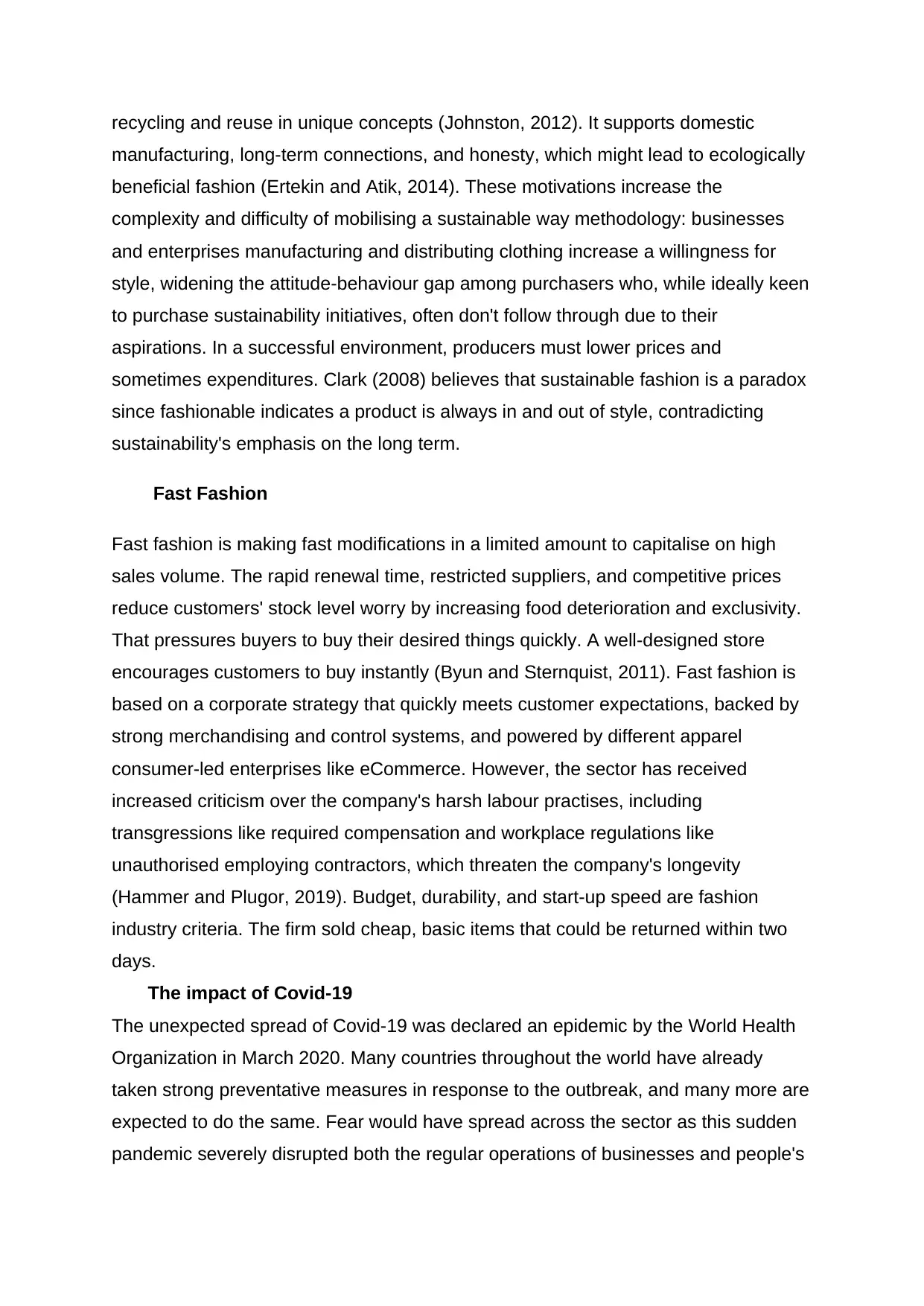
recycling and reuse in unique concepts (Johnston, 2012). It supports domestic
manufacturing, long-term connections, and honesty, which might lead to ecologically
beneficial fashion (Ertekin and Atik, 2014). These motivations increase the
complexity and difficulty of mobilising a sustainable way methodology: businesses
and enterprises manufacturing and distributing clothing increase a willingness for
style, widening the attitude-behaviour gap among purchasers who, while ideally keen
to purchase sustainability initiatives, often don't follow through due to their
aspirations. In a successful environment, producers must lower prices and
sometimes expenditures. Clark (2008) believes that sustainable fashion is a paradox
since fashionable indicates a product is always in and out of style, contradicting
sustainability's emphasis on the long term.
Fast Fashion
Fast fashion is making fast modifications in a limited amount to capitalise on high
sales volume. The rapid renewal time, restricted suppliers, and competitive prices
reduce customers' stock level worry by increasing food deterioration and exclusivity.
That pressures buyers to buy their desired things quickly. A well-designed store
encourages customers to buy instantly (Byun and Sternquist, 2011). Fast fashion is
based on a corporate strategy that quickly meets customer expectations, backed by
strong merchandising and control systems, and powered by different apparel
consumer-led enterprises like eCommerce. However, the sector has received
increased criticism over the company's harsh labour practises, including
transgressions like required compensation and workplace regulations like
unauthorised employing contractors, which threaten the company's longevity
(Hammer and Plugor, 2019). Budget, durability, and start-up speed are fashion
industry criteria. The firm sold cheap, basic items that could be returned within two
days.
The impact of Covid-19
The unexpected spread of Covid-19 was declared an epidemic by the World Health
Organization in March 2020. Many countries throughout the world have already
taken strong preventative measures in response to the outbreak, and many more are
expected to do the same. Fear would have spread across the sector as this sudden
pandemic severely disrupted both the regular operations of businesses and people's
manufacturing, long-term connections, and honesty, which might lead to ecologically
beneficial fashion (Ertekin and Atik, 2014). These motivations increase the
complexity and difficulty of mobilising a sustainable way methodology: businesses
and enterprises manufacturing and distributing clothing increase a willingness for
style, widening the attitude-behaviour gap among purchasers who, while ideally keen
to purchase sustainability initiatives, often don't follow through due to their
aspirations. In a successful environment, producers must lower prices and
sometimes expenditures. Clark (2008) believes that sustainable fashion is a paradox
since fashionable indicates a product is always in and out of style, contradicting
sustainability's emphasis on the long term.
Fast Fashion
Fast fashion is making fast modifications in a limited amount to capitalise on high
sales volume. The rapid renewal time, restricted suppliers, and competitive prices
reduce customers' stock level worry by increasing food deterioration and exclusivity.
That pressures buyers to buy their desired things quickly. A well-designed store
encourages customers to buy instantly (Byun and Sternquist, 2011). Fast fashion is
based on a corporate strategy that quickly meets customer expectations, backed by
strong merchandising and control systems, and powered by different apparel
consumer-led enterprises like eCommerce. However, the sector has received
increased criticism over the company's harsh labour practises, including
transgressions like required compensation and workplace regulations like
unauthorised employing contractors, which threaten the company's longevity
(Hammer and Plugor, 2019). Budget, durability, and start-up speed are fashion
industry criteria. The firm sold cheap, basic items that could be returned within two
days.
The impact of Covid-19
The unexpected spread of Covid-19 was declared an epidemic by the World Health
Organization in March 2020. Many countries throughout the world have already
taken strong preventative measures in response to the outbreak, and many more are
expected to do the same. Fear would have spread across the sector as this sudden
pandemic severely disrupted both the regular operations of businesses and people's
Paraphrase This Document
Need a fresh take? Get an instant paraphrase of this document with our AI Paraphraser
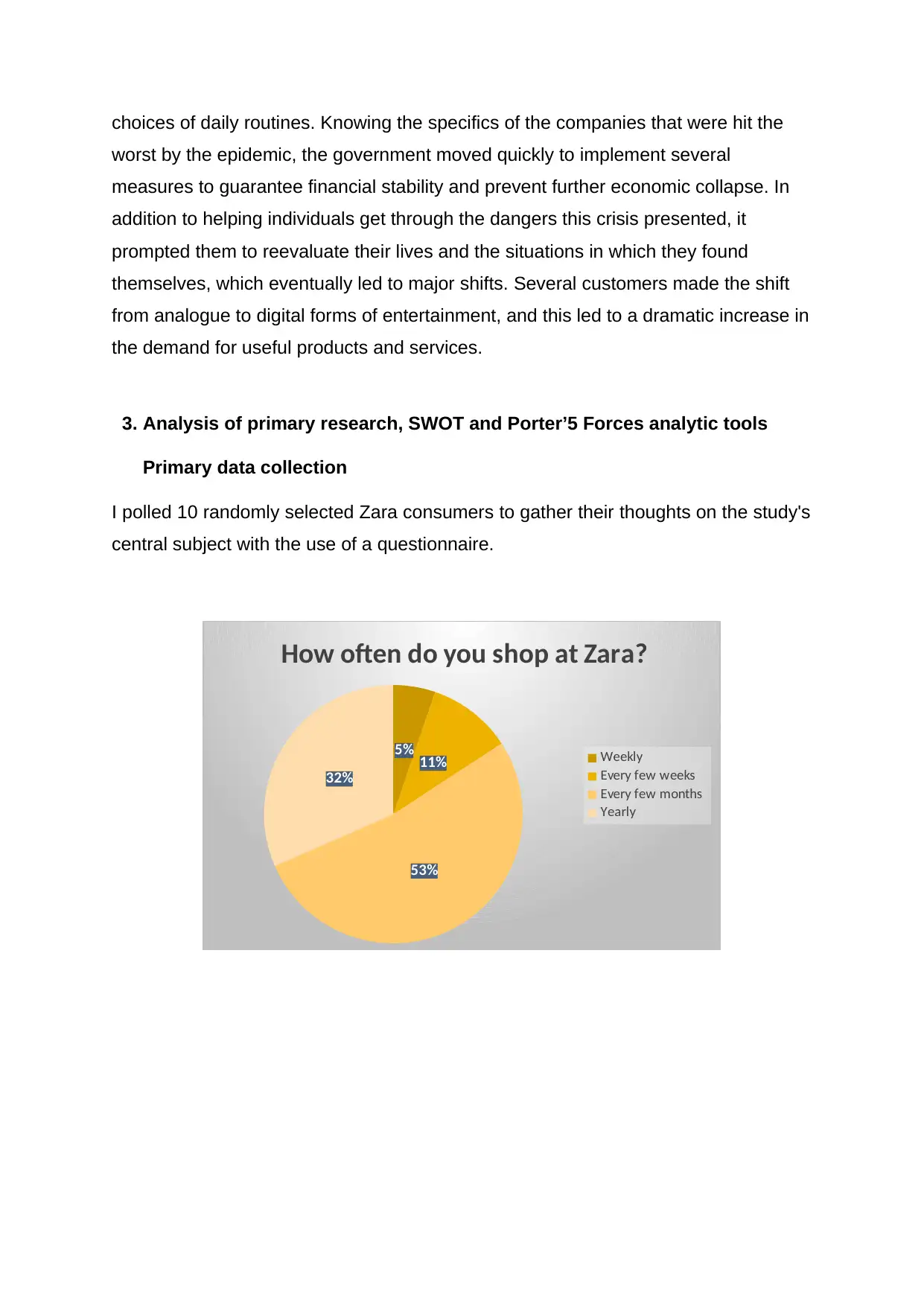
choices of daily routines. Knowing the specifics of the companies that were hit the
worst by the epidemic, the government moved quickly to implement several
measures to guarantee financial stability and prevent further economic collapse. In
addition to helping individuals get through the dangers this crisis presented, it
prompted them to reevaluate their lives and the situations in which they found
themselves, which eventually led to major shifts. Several customers made the shift
from analogue to digital forms of entertainment, and this led to a dramatic increase in
the demand for useful products and services.
3. Analysis of primary research, SWOT and Porter’5 Forces analytic tools
Primary data collection
I polled 10 randomly selected Zara consumers to gather their thoughts on the study's
central subject with the use of a questionnaire.
5% 11%
53%
32%
How often do you shop at Zara?
Weekly
Every few weeks
Every few months
Yearly
worst by the epidemic, the government moved quickly to implement several
measures to guarantee financial stability and prevent further economic collapse. In
addition to helping individuals get through the dangers this crisis presented, it
prompted them to reevaluate their lives and the situations in which they found
themselves, which eventually led to major shifts. Several customers made the shift
from analogue to digital forms of entertainment, and this led to a dramatic increase in
the demand for useful products and services.
3. Analysis of primary research, SWOT and Porter’5 Forces analytic tools
Primary data collection
I polled 10 randomly selected Zara consumers to gather their thoughts on the study's
central subject with the use of a questionnaire.
5% 11%
53%
32%
How often do you shop at Zara?
Weekly
Every few weeks
Every few months
Yearly
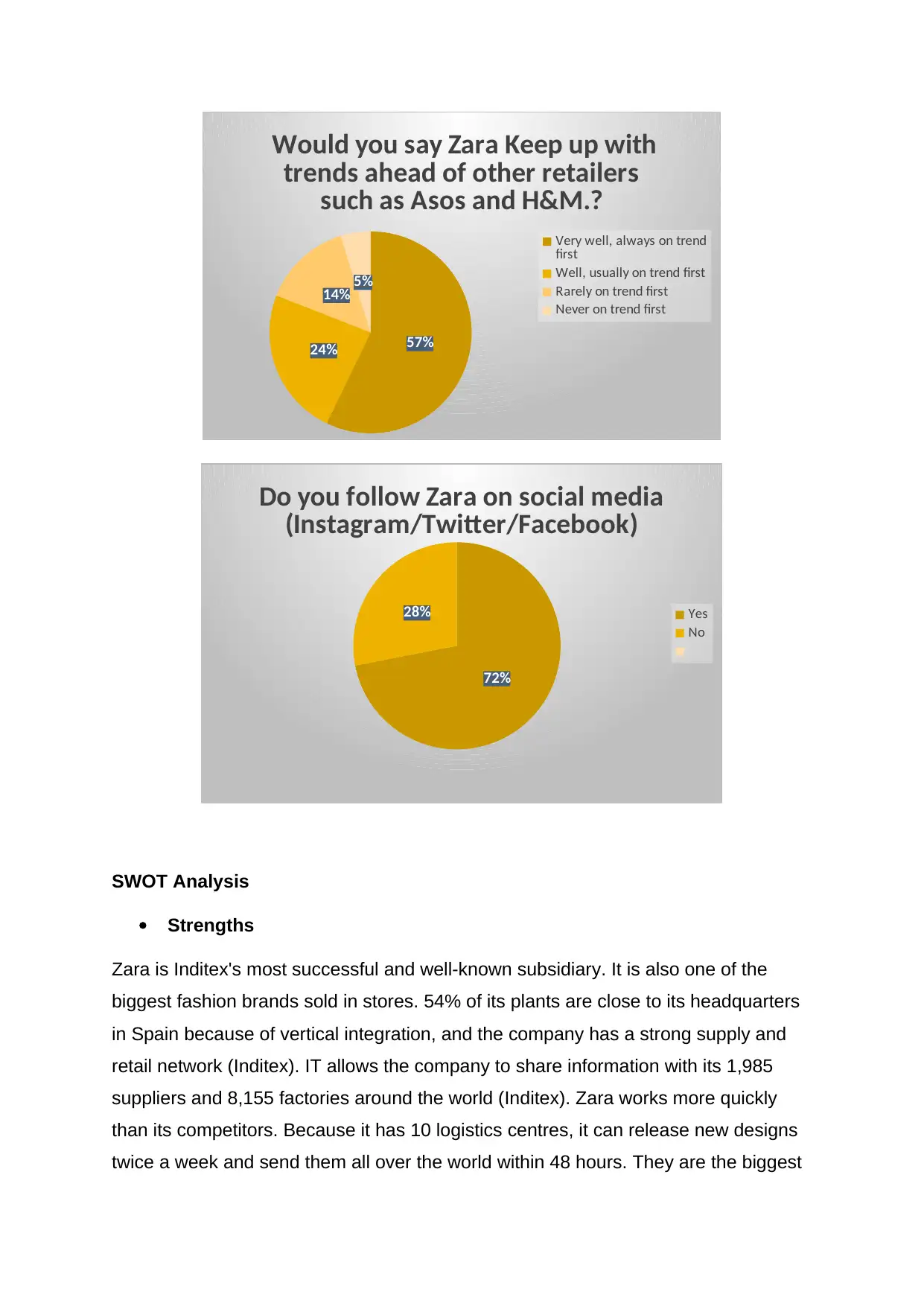
57%24%
14% 5%
Would you say Zara Keep up with
trends ahead of other retailers
such as Asos and H&M.?
Very well, always on trend
first
Well, usually on trend first
Rarely on trend first
Never on trend first
72%
28%
Do you follow Zara on social media
(Instagram/Twitter/Facebook)
Yes
No
SWOT Analysis
Strengths
Zara is Inditex's most successful and well-known subsidiary. It is also one of the
biggest fashion brands sold in stores. 54% of its plants are close to its headquarters
in Spain because of vertical integration, and the company has a strong supply and
retail network (Inditex). IT allows the company to share information with its 1,985
suppliers and 8,155 factories around the world (Inditex). Zara works more quickly
than its competitors. Because it has 10 logistics centres, it can release new designs
twice a week and send them all over the world within 48 hours. They are the biggest
14% 5%
Would you say Zara Keep up with
trends ahead of other retailers
such as Asos and H&M.?
Very well, always on trend
first
Well, usually on trend first
Rarely on trend first
Never on trend first
72%
28%
Do you follow Zara on social media
(Instagram/Twitter/Facebook)
Yes
No
SWOT Analysis
Strengths
Zara is Inditex's most successful and well-known subsidiary. It is also one of the
biggest fashion brands sold in stores. 54% of its plants are close to its headquarters
in Spain because of vertical integration, and the company has a strong supply and
retail network (Inditex). IT allows the company to share information with its 1,985
suppliers and 8,155 factories around the world (Inditex). Zara works more quickly
than its competitors. Because it has 10 logistics centres, it can release new designs
twice a week and send them all over the world within 48 hours. They are the biggest
⊘ This is a preview!⊘
Do you want full access?
Subscribe today to unlock all pages.

Trusted by 1+ million students worldwide
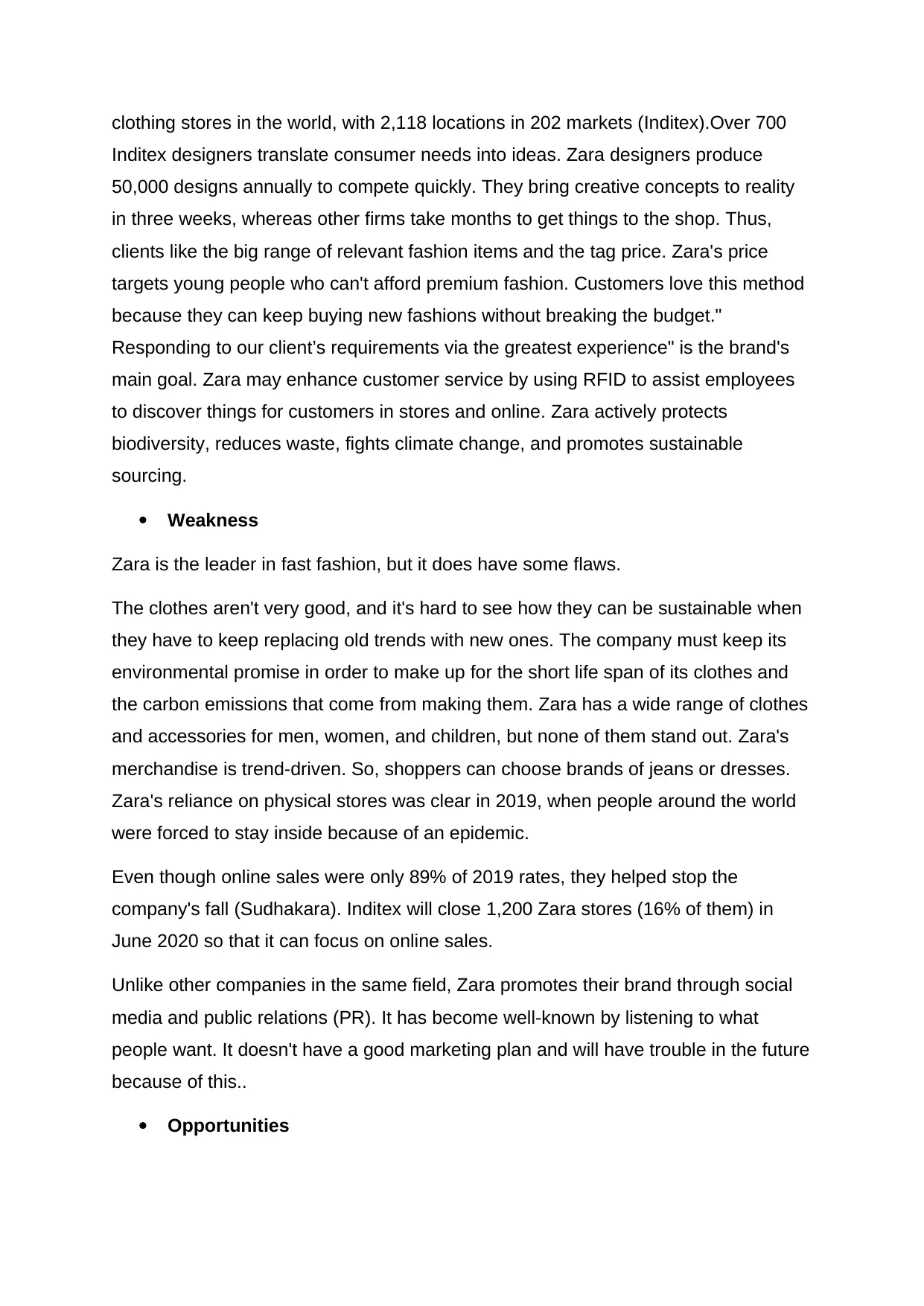
clothing stores in the world, with 2,118 locations in 202 markets (Inditex).Over 700
Inditex designers translate consumer needs into ideas. Zara designers produce
50,000 designs annually to compete quickly. They bring creative concepts to reality
in three weeks, whereas other firms take months to get things to the shop. Thus,
clients like the big range of relevant fashion items and the tag price. Zara's price
targets young people who can't afford premium fashion. Customers love this method
because they can keep buying new fashions without breaking the budget."
Responding to our client’s requirements via the greatest experience" is the brand's
main goal. Zara may enhance customer service by using RFID to assist employees
to discover things for customers in stores and online. Zara actively protects
biodiversity, reduces waste, fights climate change, and promotes sustainable
sourcing.
Weakness
Zara is the leader in fast fashion, but it does have some flaws.
The clothes aren't very good, and it's hard to see how they can be sustainable when
they have to keep replacing old trends with new ones. The company must keep its
environmental promise in order to make up for the short life span of its clothes and
the carbon emissions that come from making them. Zara has a wide range of clothes
and accessories for men, women, and children, but none of them stand out. Zara's
merchandise is trend-driven. So, shoppers can choose brands of jeans or dresses.
Zara's reliance on physical stores was clear in 2019, when people around the world
were forced to stay inside because of an epidemic.
Even though online sales were only 89% of 2019 rates, they helped stop the
company's fall (Sudhakara). Inditex will close 1,200 Zara stores (16% of them) in
June 2020 so that it can focus on online sales.
Unlike other companies in the same field, Zara promotes their brand through social
media and public relations (PR). It has become well-known by listening to what
people want. It doesn't have a good marketing plan and will have trouble in the future
because of this..
Opportunities
Inditex designers translate consumer needs into ideas. Zara designers produce
50,000 designs annually to compete quickly. They bring creative concepts to reality
in three weeks, whereas other firms take months to get things to the shop. Thus,
clients like the big range of relevant fashion items and the tag price. Zara's price
targets young people who can't afford premium fashion. Customers love this method
because they can keep buying new fashions without breaking the budget."
Responding to our client’s requirements via the greatest experience" is the brand's
main goal. Zara may enhance customer service by using RFID to assist employees
to discover things for customers in stores and online. Zara actively protects
biodiversity, reduces waste, fights climate change, and promotes sustainable
sourcing.
Weakness
Zara is the leader in fast fashion, but it does have some flaws.
The clothes aren't very good, and it's hard to see how they can be sustainable when
they have to keep replacing old trends with new ones. The company must keep its
environmental promise in order to make up for the short life span of its clothes and
the carbon emissions that come from making them. Zara has a wide range of clothes
and accessories for men, women, and children, but none of them stand out. Zara's
merchandise is trend-driven. So, shoppers can choose brands of jeans or dresses.
Zara's reliance on physical stores was clear in 2019, when people around the world
were forced to stay inside because of an epidemic.
Even though online sales were only 89% of 2019 rates, they helped stop the
company's fall (Sudhakara). Inditex will close 1,200 Zara stores (16% of them) in
June 2020 so that it can focus on online sales.
Unlike other companies in the same field, Zara promotes their brand through social
media and public relations (PR). It has become well-known by listening to what
people want. It doesn't have a good marketing plan and will have trouble in the future
because of this..
Opportunities
Paraphrase This Document
Need a fresh take? Get an instant paraphrase of this document with our AI Paraphraser
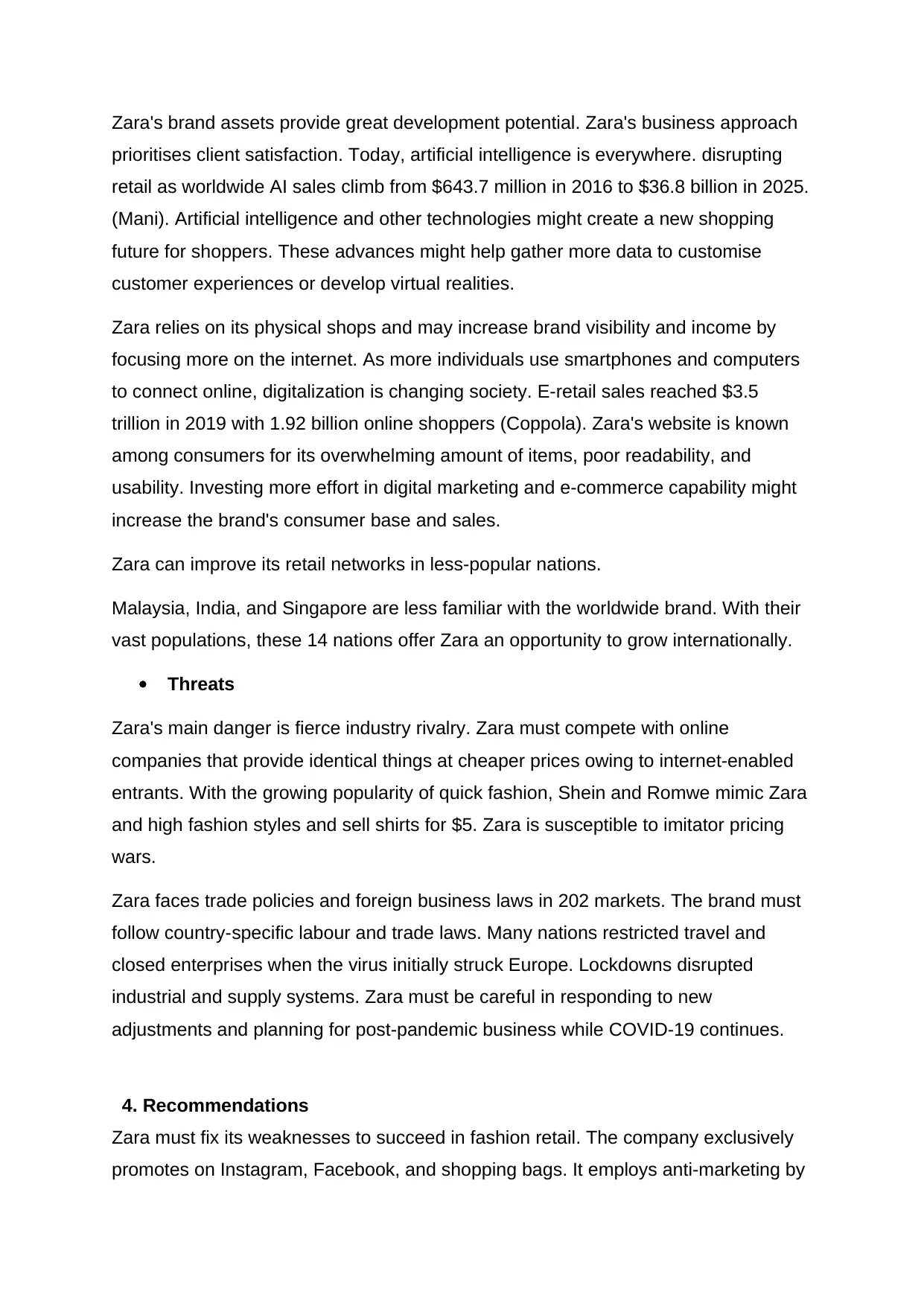
Zara's brand assets provide great development potential. Zara's business approach
prioritises client satisfaction. Today, artificial intelligence is everywhere. disrupting
retail as worldwide AI sales climb from $643.7 million in 2016 to $36.8 billion in 2025.
(Mani). Artificial intelligence and other technologies might create a new shopping
future for shoppers. These advances might help gather more data to customise
customer experiences or develop virtual realities.
Zara relies on its physical shops and may increase brand visibility and income by
focusing more on the internet. As more individuals use smartphones and computers
to connect online, digitalization is changing society. E-retail sales reached $3.5
trillion in 2019 with 1.92 billion online shoppers (Coppola). Zara's website is known
among consumers for its overwhelming amount of items, poor readability, and
usability. Investing more effort in digital marketing and e-commerce capability might
increase the brand's consumer base and sales.
Zara can improve its retail networks in less-popular nations.
Malaysia, India, and Singapore are less familiar with the worldwide brand. With their
vast populations, these 14 nations offer Zara an opportunity to grow internationally.
Threats
Zara's main danger is fierce industry rivalry. Zara must compete with online
companies that provide identical things at cheaper prices owing to internet-enabled
entrants. With the growing popularity of quick fashion, Shein and Romwe mimic Zara
and high fashion styles and sell shirts for $5. Zara is susceptible to imitator pricing
wars.
Zara faces trade policies and foreign business laws in 202 markets. The brand must
follow country-specific labour and trade laws. Many nations restricted travel and
closed enterprises when the virus initially struck Europe. Lockdowns disrupted
industrial and supply systems. Zara must be careful in responding to new
adjustments and planning for post-pandemic business while COVID-19 continues.
4. Recommendations
Zara must fix its weaknesses to succeed in fashion retail. The company exclusively
promotes on Instagram, Facebook, and shopping bags. It employs anti-marketing by
prioritises client satisfaction. Today, artificial intelligence is everywhere. disrupting
retail as worldwide AI sales climb from $643.7 million in 2016 to $36.8 billion in 2025.
(Mani). Artificial intelligence and other technologies might create a new shopping
future for shoppers. These advances might help gather more data to customise
customer experiences or develop virtual realities.
Zara relies on its physical shops and may increase brand visibility and income by
focusing more on the internet. As more individuals use smartphones and computers
to connect online, digitalization is changing society. E-retail sales reached $3.5
trillion in 2019 with 1.92 billion online shoppers (Coppola). Zara's website is known
among consumers for its overwhelming amount of items, poor readability, and
usability. Investing more effort in digital marketing and e-commerce capability might
increase the brand's consumer base and sales.
Zara can improve its retail networks in less-popular nations.
Malaysia, India, and Singapore are less familiar with the worldwide brand. With their
vast populations, these 14 nations offer Zara an opportunity to grow internationally.
Threats
Zara's main danger is fierce industry rivalry. Zara must compete with online
companies that provide identical things at cheaper prices owing to internet-enabled
entrants. With the growing popularity of quick fashion, Shein and Romwe mimic Zara
and high fashion styles and sell shirts for $5. Zara is susceptible to imitator pricing
wars.
Zara faces trade policies and foreign business laws in 202 markets. The brand must
follow country-specific labour and trade laws. Many nations restricted travel and
closed enterprises when the virus initially struck Europe. Lockdowns disrupted
industrial and supply systems. Zara must be careful in responding to new
adjustments and planning for post-pandemic business while COVID-19 continues.
4. Recommendations
Zara must fix its weaknesses to succeed in fashion retail. The company exclusively
promotes on Instagram, Facebook, and shopping bags. It employs anti-marketing by
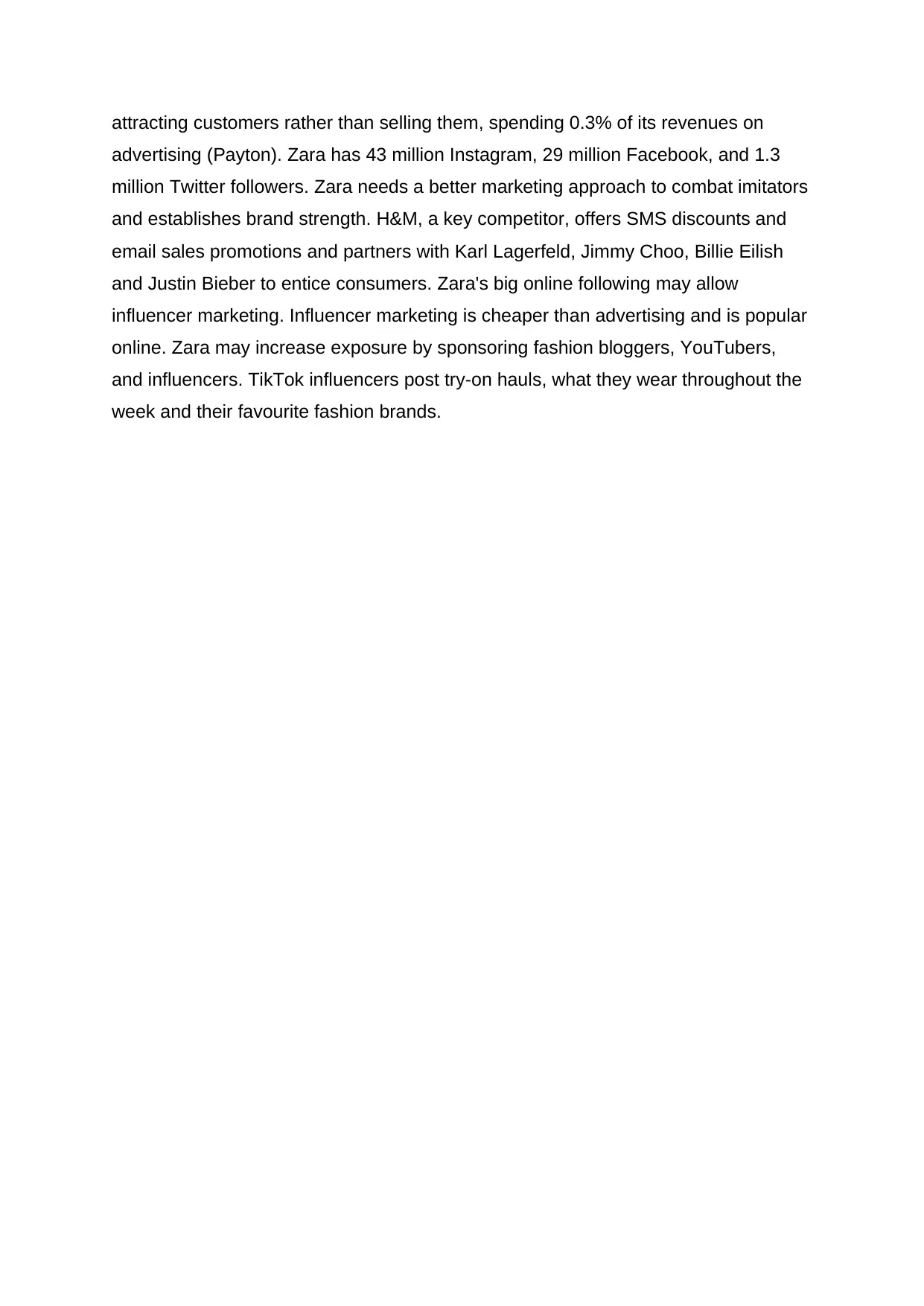
attracting customers rather than selling them, spending 0.3% of its revenues on
advertising (Payton). Zara has 43 million Instagram, 29 million Facebook, and 1.3
million Twitter followers. Zara needs a better marketing approach to combat imitators
and establishes brand strength. H&M, a key competitor, offers SMS discounts and
email sales promotions and partners with Karl Lagerfeld, Jimmy Choo, Billie Eilish
and Justin Bieber to entice consumers. Zara's big online following may allow
influencer marketing. Influencer marketing is cheaper than advertising and is popular
online. Zara may increase exposure by sponsoring fashion bloggers, YouTubers,
and influencers. TikTok influencers post try-on hauls, what they wear throughout the
week and their favourite fashion brands.
advertising (Payton). Zara has 43 million Instagram, 29 million Facebook, and 1.3
million Twitter followers. Zara needs a better marketing approach to combat imitators
and establishes brand strength. H&M, a key competitor, offers SMS discounts and
email sales promotions and partners with Karl Lagerfeld, Jimmy Choo, Billie Eilish
and Justin Bieber to entice consumers. Zara's big online following may allow
influencer marketing. Influencer marketing is cheaper than advertising and is popular
online. Zara may increase exposure by sponsoring fashion bloggers, YouTubers,
and influencers. TikTok influencers post try-on hauls, what they wear throughout the
week and their favourite fashion brands.
⊘ This is a preview!⊘
Do you want full access?
Subscribe today to unlock all pages.

Trusted by 1+ million students worldwide
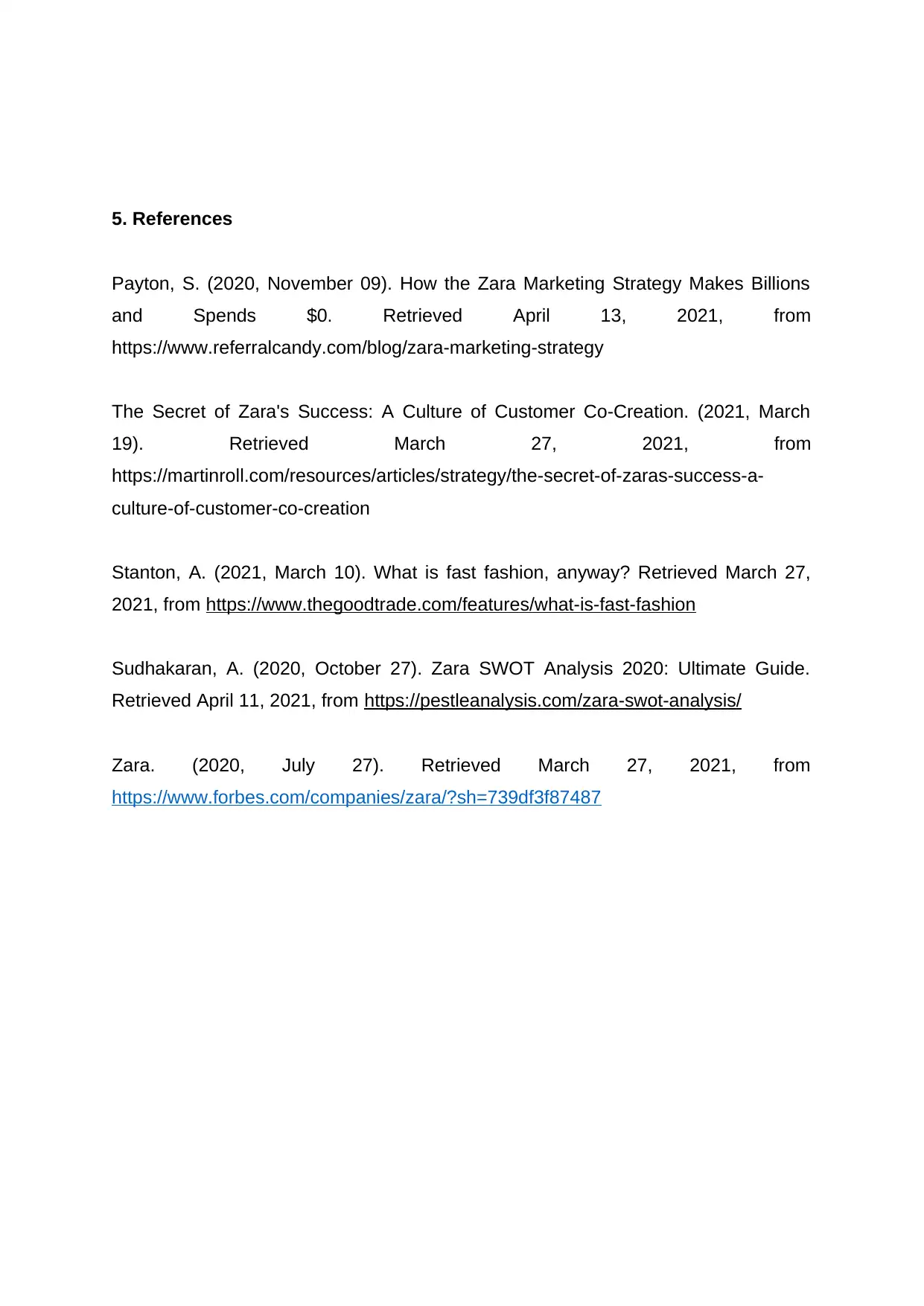
5. References
Payton, S. (2020, November 09). How the Zara Marketing Strategy Makes Billions
and Spends $0. Retrieved April 13, 2021, from
https://www.referralcandy.com/blog/zara-marketing-strategy
The Secret of Zara's Success: A Culture of Customer Co-Creation. (2021, March
19). Retrieved March 27, 2021, from
https://martinroll.com/resources/articles/strategy/the-secret-of-zaras-success-a-
culture-of-customer-co-creation
Stanton, A. (2021, March 10). What is fast fashion, anyway? Retrieved March 27,
2021, from https://www.thegoodtrade.com/features/what-is-fast-fashion
Sudhakaran, A. (2020, October 27). Zara SWOT Analysis 2020: Ultimate Guide.
Retrieved April 11, 2021, from https://pestleanalysis.com/zara-swot-analysis/
Zara. (2020, July 27). Retrieved March 27, 2021, from
https://www.forbes.com/companies/zara/?sh=739df3f87487
Payton, S. (2020, November 09). How the Zara Marketing Strategy Makes Billions
and Spends $0. Retrieved April 13, 2021, from
https://www.referralcandy.com/blog/zara-marketing-strategy
The Secret of Zara's Success: A Culture of Customer Co-Creation. (2021, March
19). Retrieved March 27, 2021, from
https://martinroll.com/resources/articles/strategy/the-secret-of-zaras-success-a-
culture-of-customer-co-creation
Stanton, A. (2021, March 10). What is fast fashion, anyway? Retrieved March 27,
2021, from https://www.thegoodtrade.com/features/what-is-fast-fashion
Sudhakaran, A. (2020, October 27). Zara SWOT Analysis 2020: Ultimate Guide.
Retrieved April 11, 2021, from https://pestleanalysis.com/zara-swot-analysis/
Zara. (2020, July 27). Retrieved March 27, 2021, from
https://www.forbes.com/companies/zara/?sh=739df3f87487
Paraphrase This Document
Need a fresh take? Get an instant paraphrase of this document with our AI Paraphraser
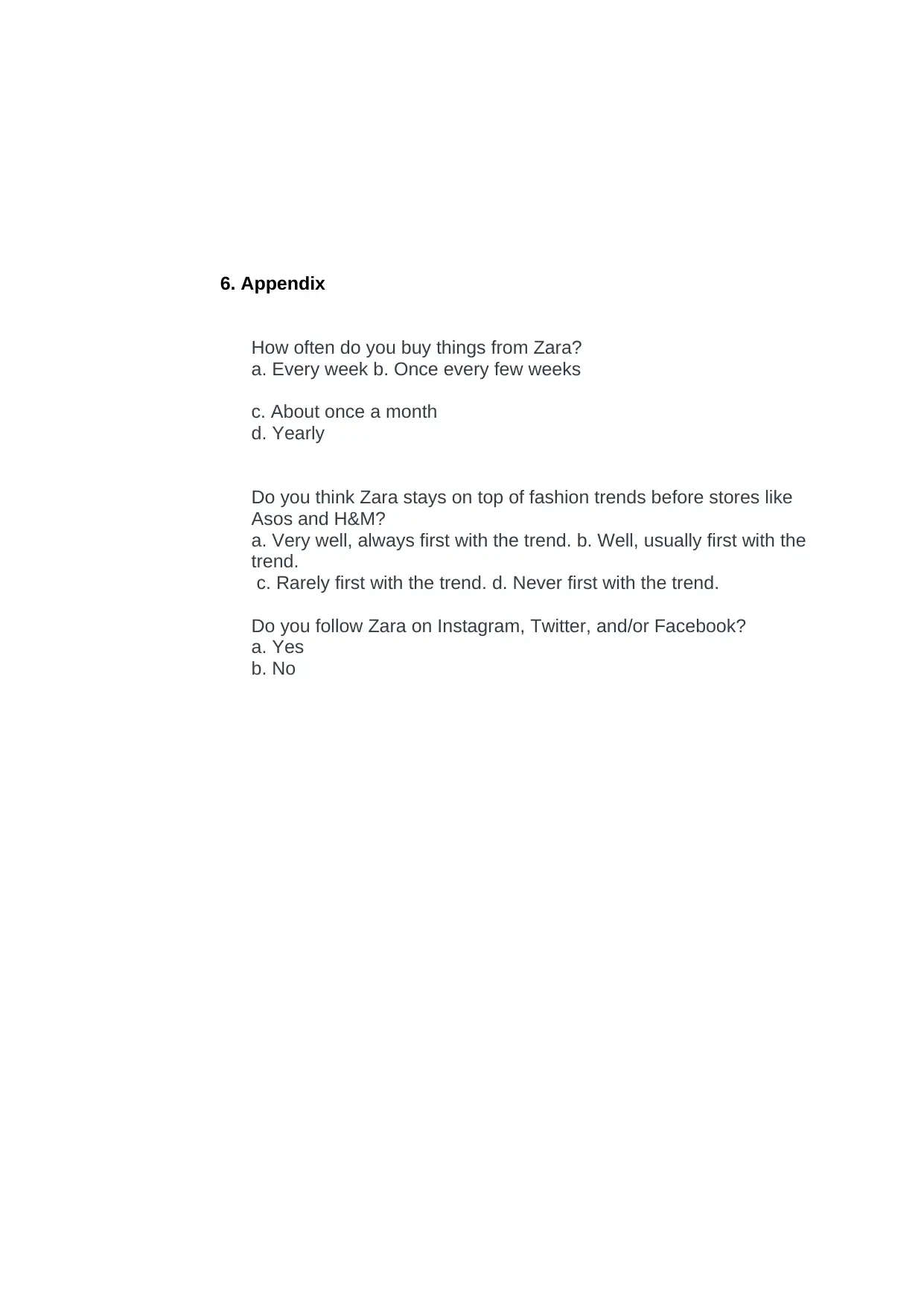
6. Appendix
How often do you buy things from Zara?
a. Every week b. Once every few weeks
c. About once a month
d. Yearly
Do you think Zara stays on top of fashion trends before stores like
Asos and H&M?
a. Very well, always first with the trend. b. Well, usually first with the
trend.
c. Rarely first with the trend. d. Never first with the trend.
Do you follow Zara on Instagram, Twitter, and/or Facebook?
a. Yes
b. No
How often do you buy things from Zara?
a. Every week b. Once every few weeks
c. About once a month
d. Yearly
Do you think Zara stays on top of fashion trends before stores like
Asos and H&M?
a. Very well, always first with the trend. b. Well, usually first with the
trend.
c. Rarely first with the trend. d. Never first with the trend.
Do you follow Zara on Instagram, Twitter, and/or Facebook?
a. Yes
b. No
1 out of 11
Related Documents
Your All-in-One AI-Powered Toolkit for Academic Success.
+13062052269
info@desklib.com
Available 24*7 on WhatsApp / Email
![[object Object]](/_next/static/media/star-bottom.7253800d.svg)
Unlock your academic potential
Copyright © 2020–2025 A2Z Services. All Rights Reserved. Developed and managed by ZUCOL.





